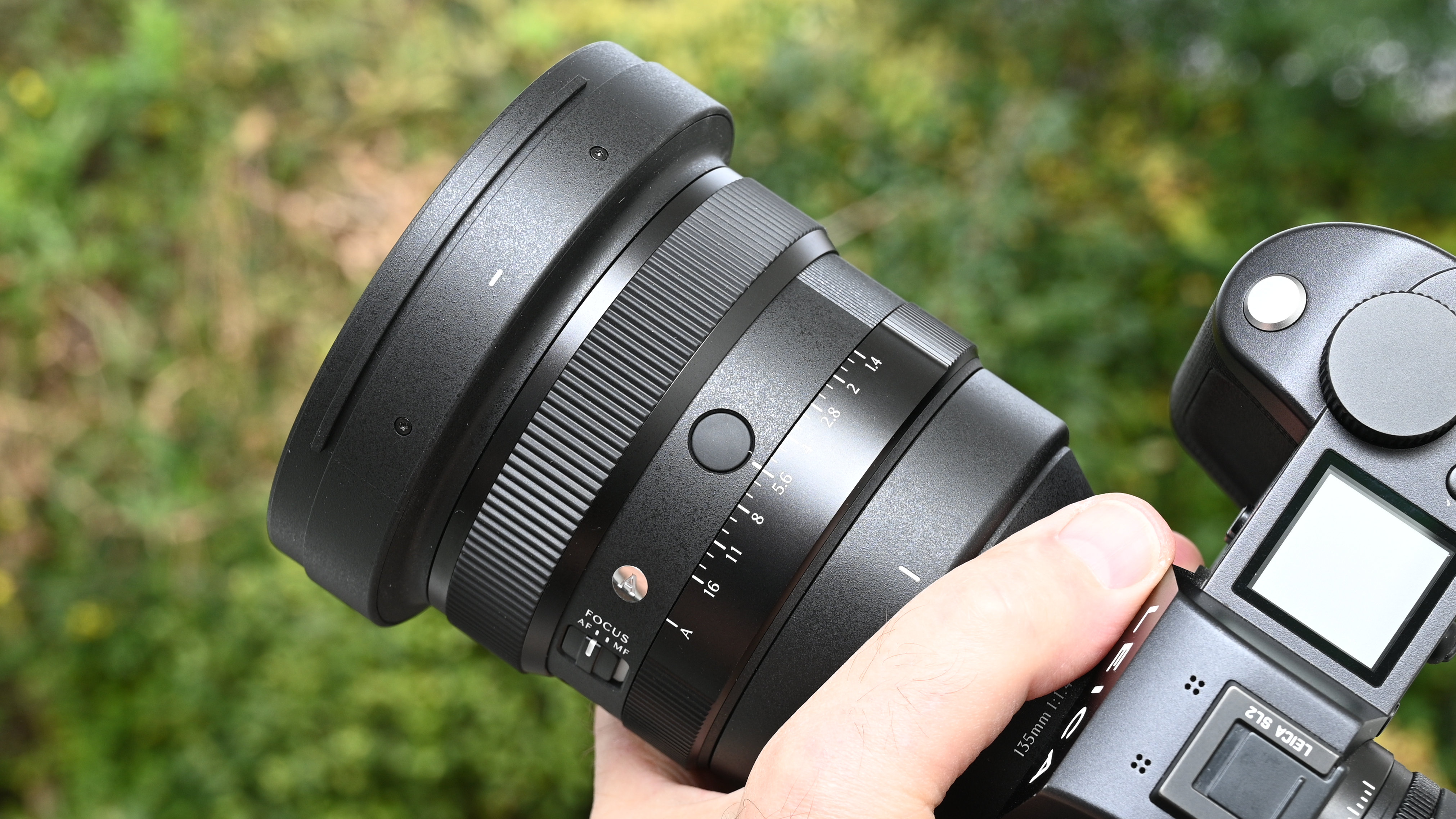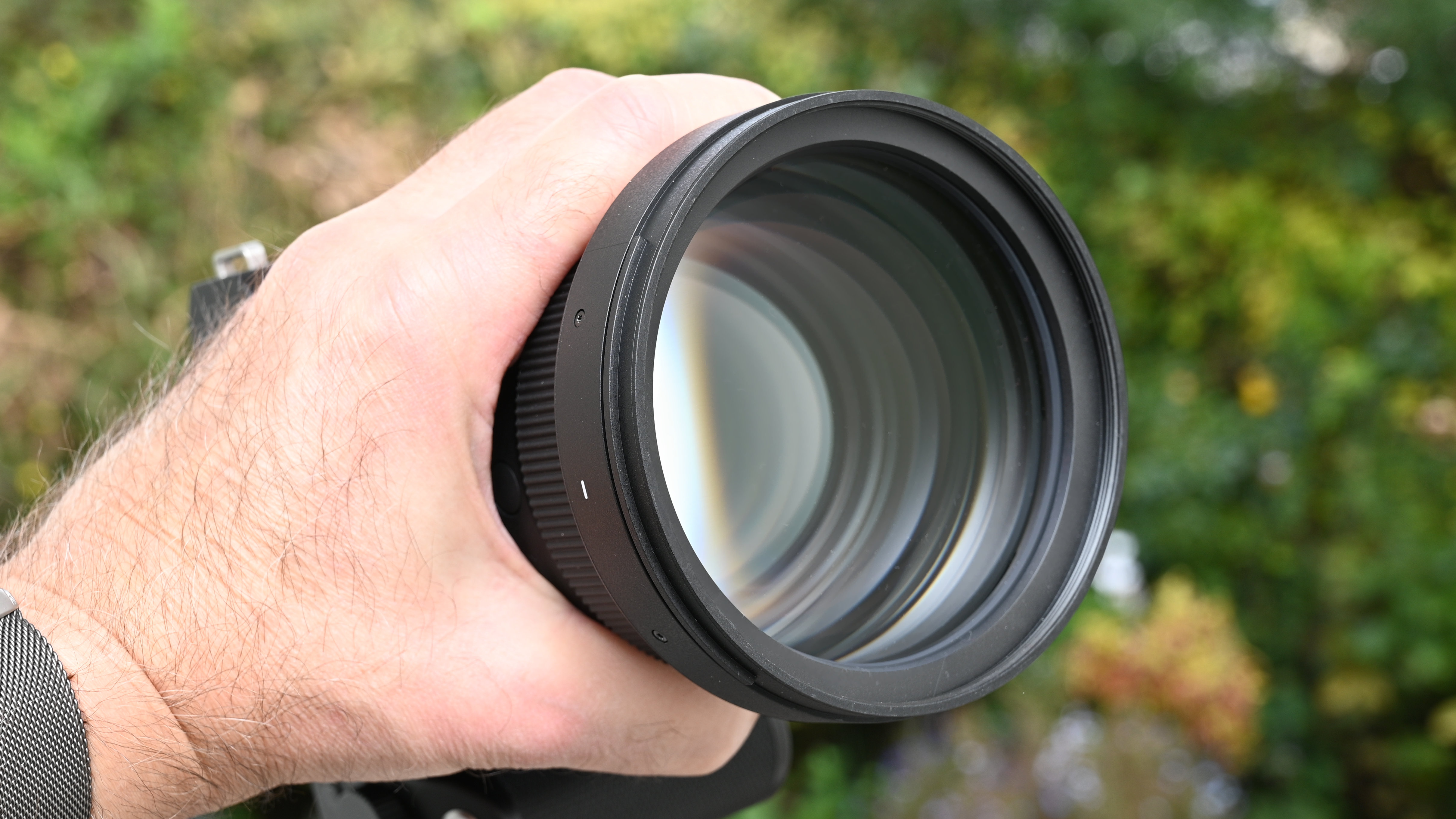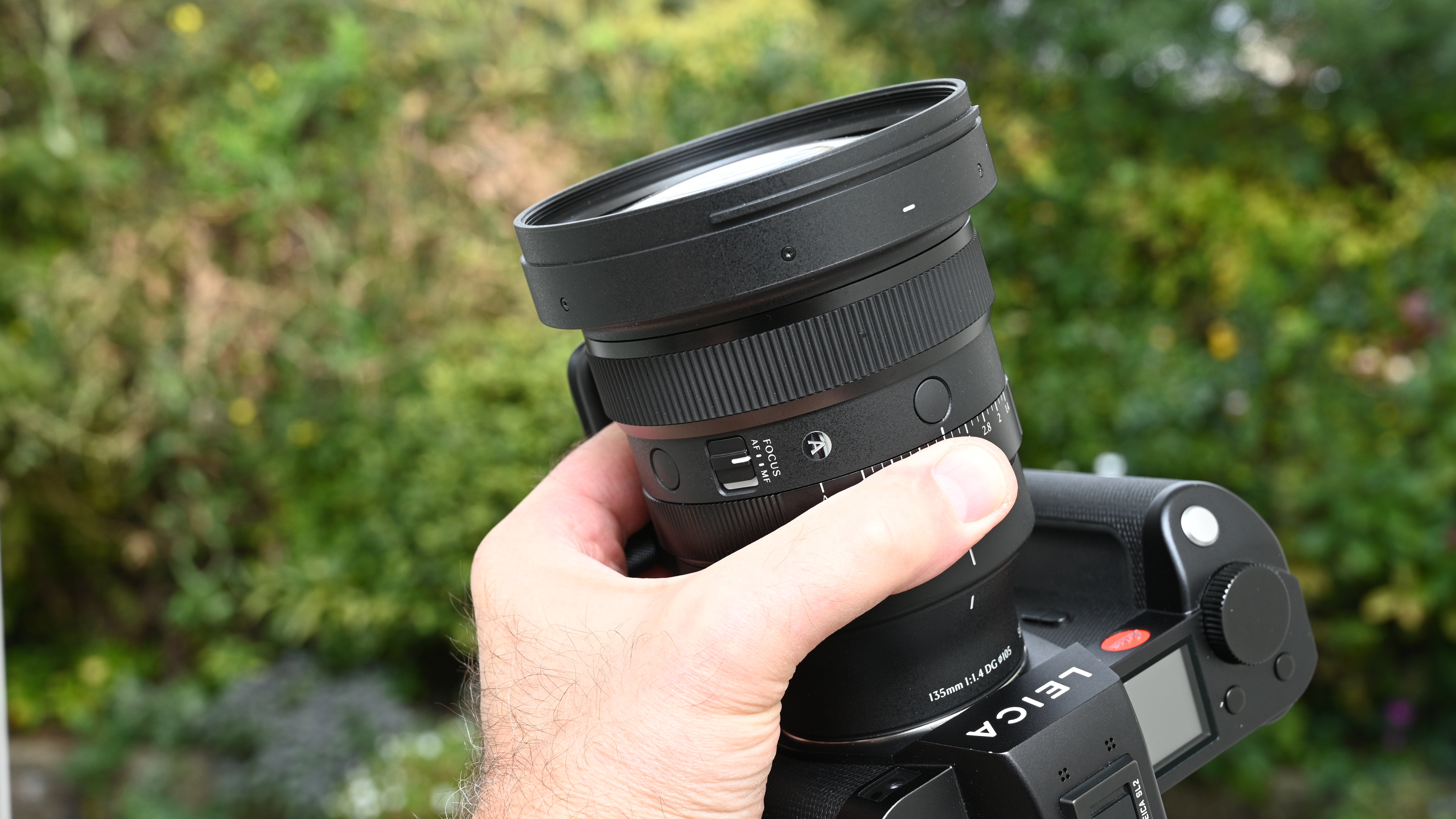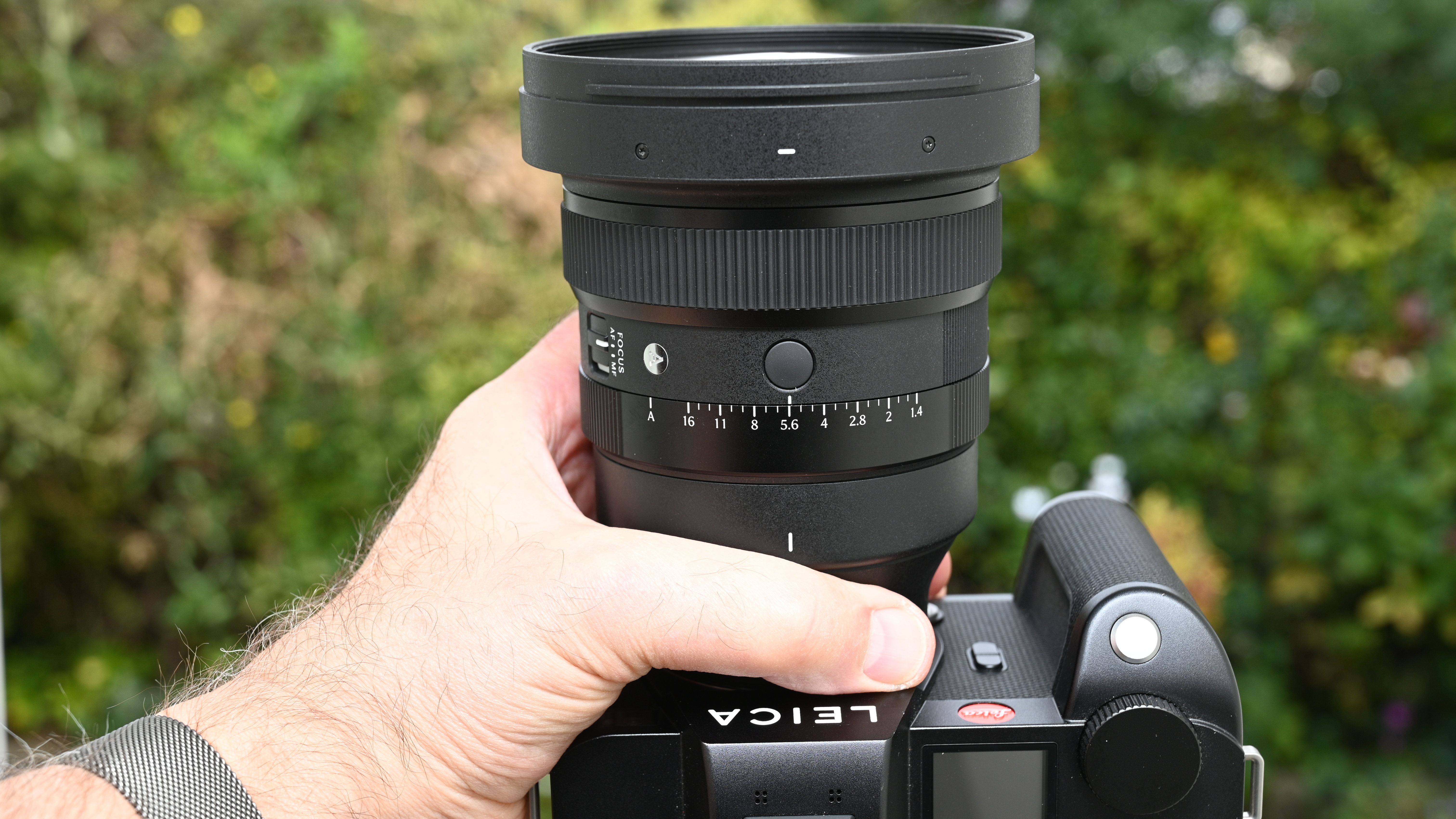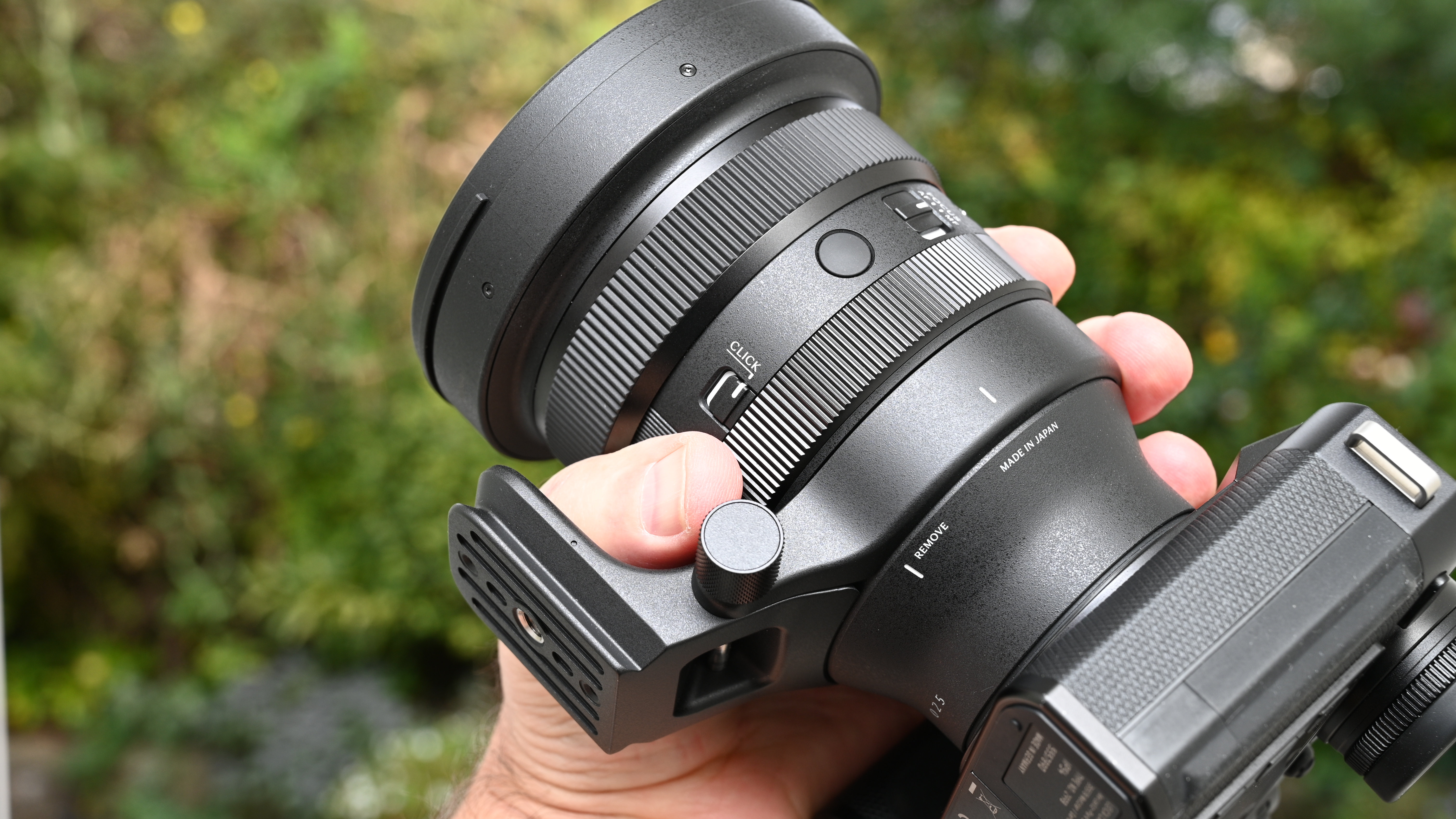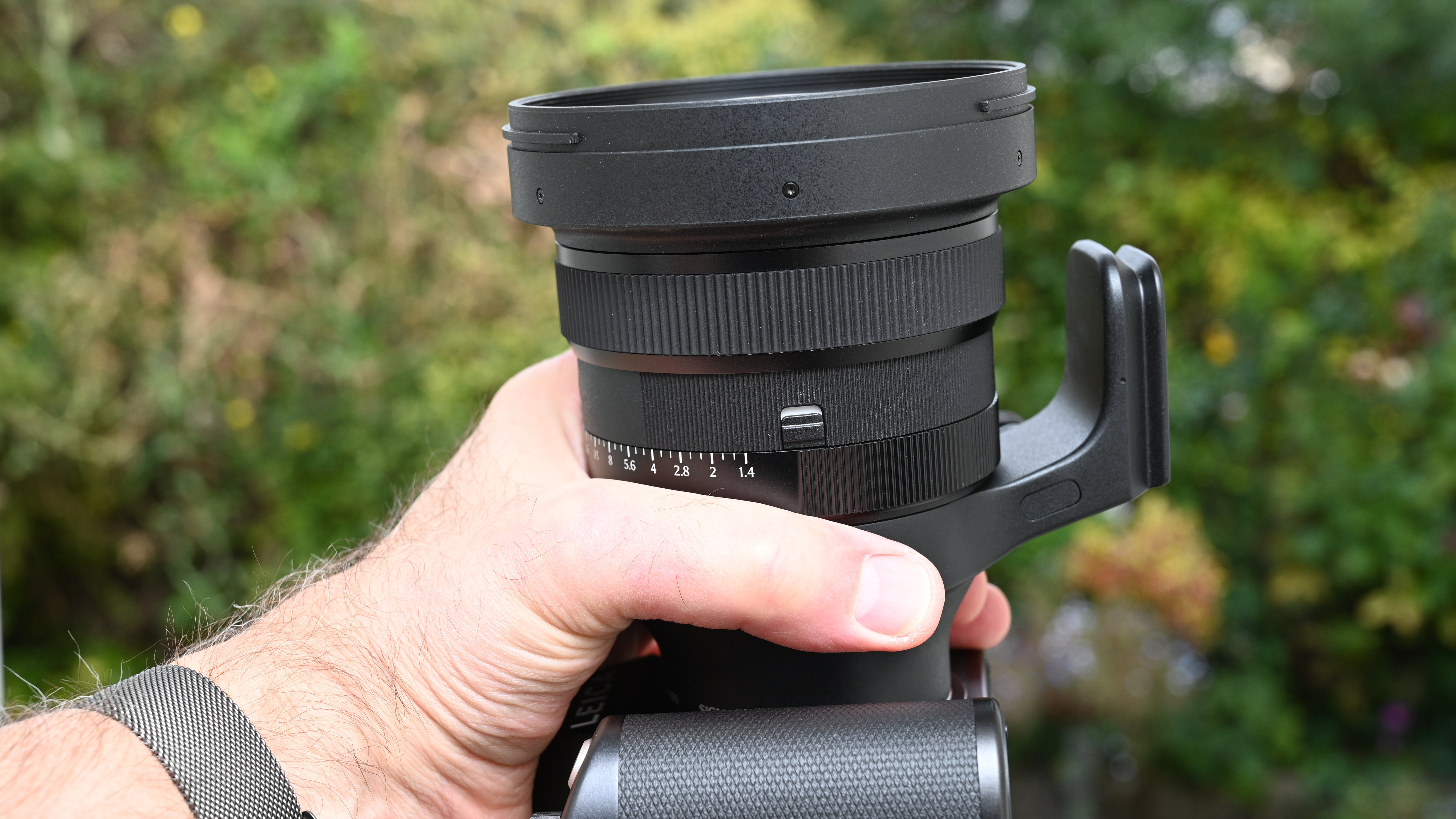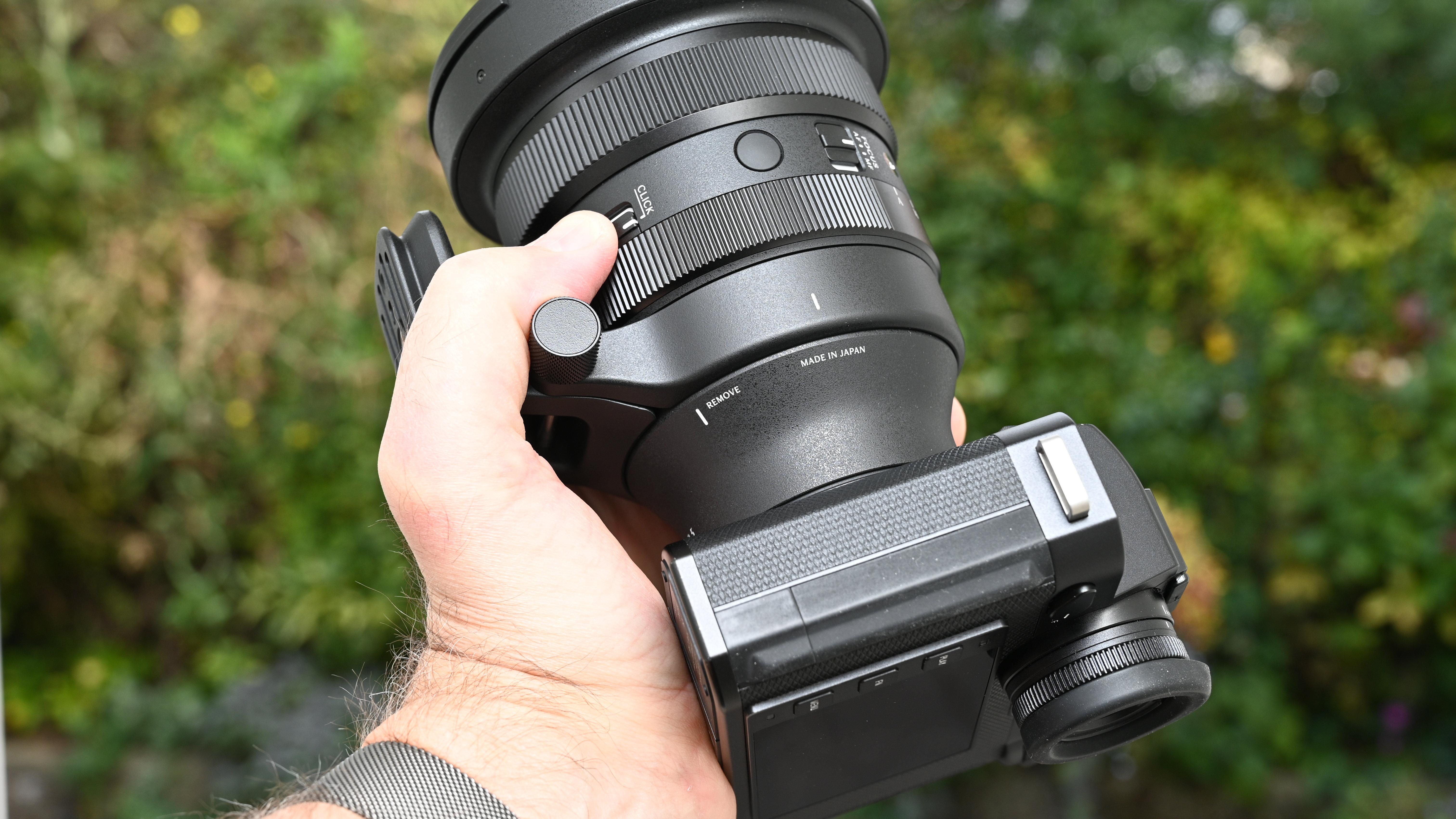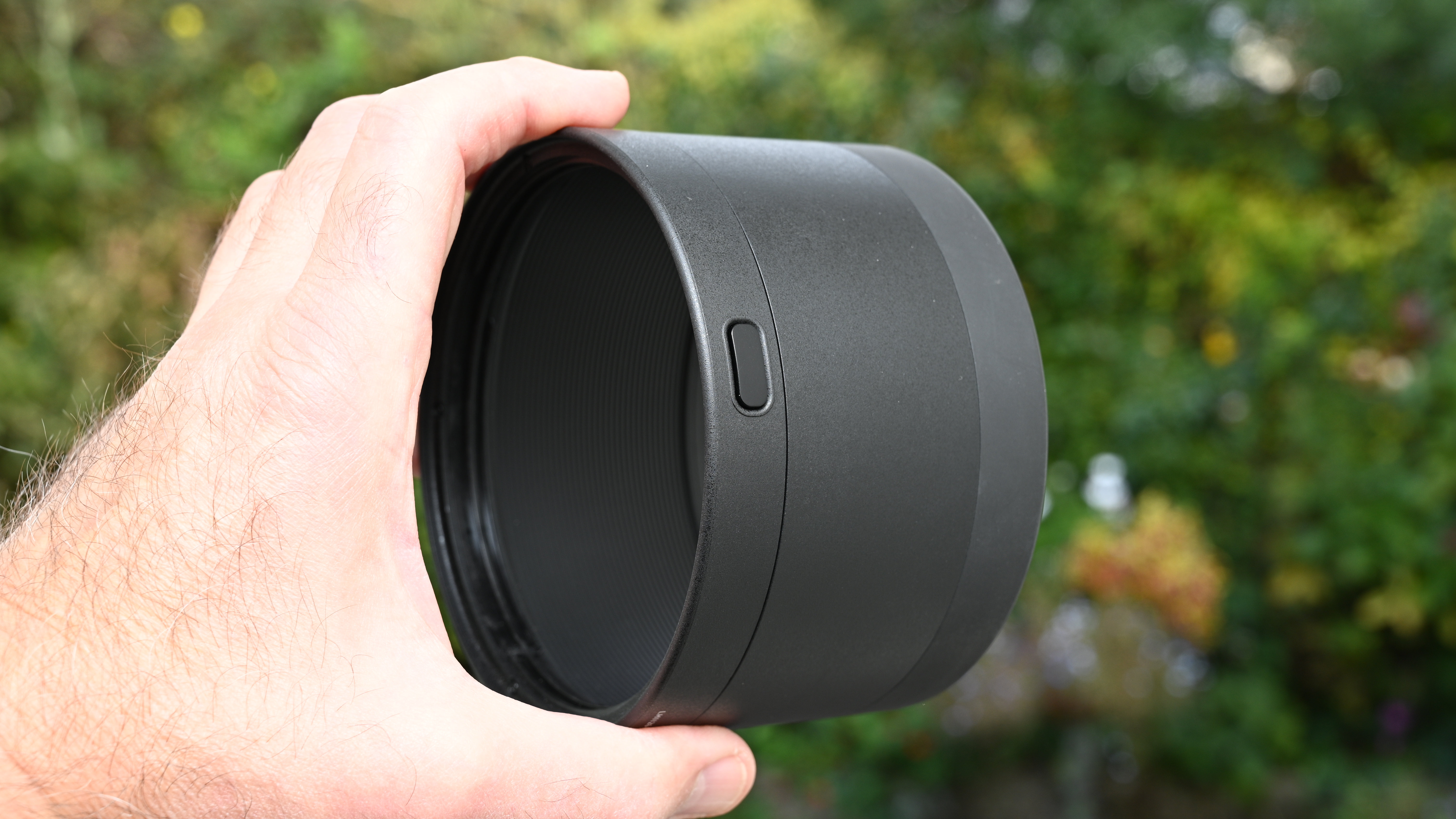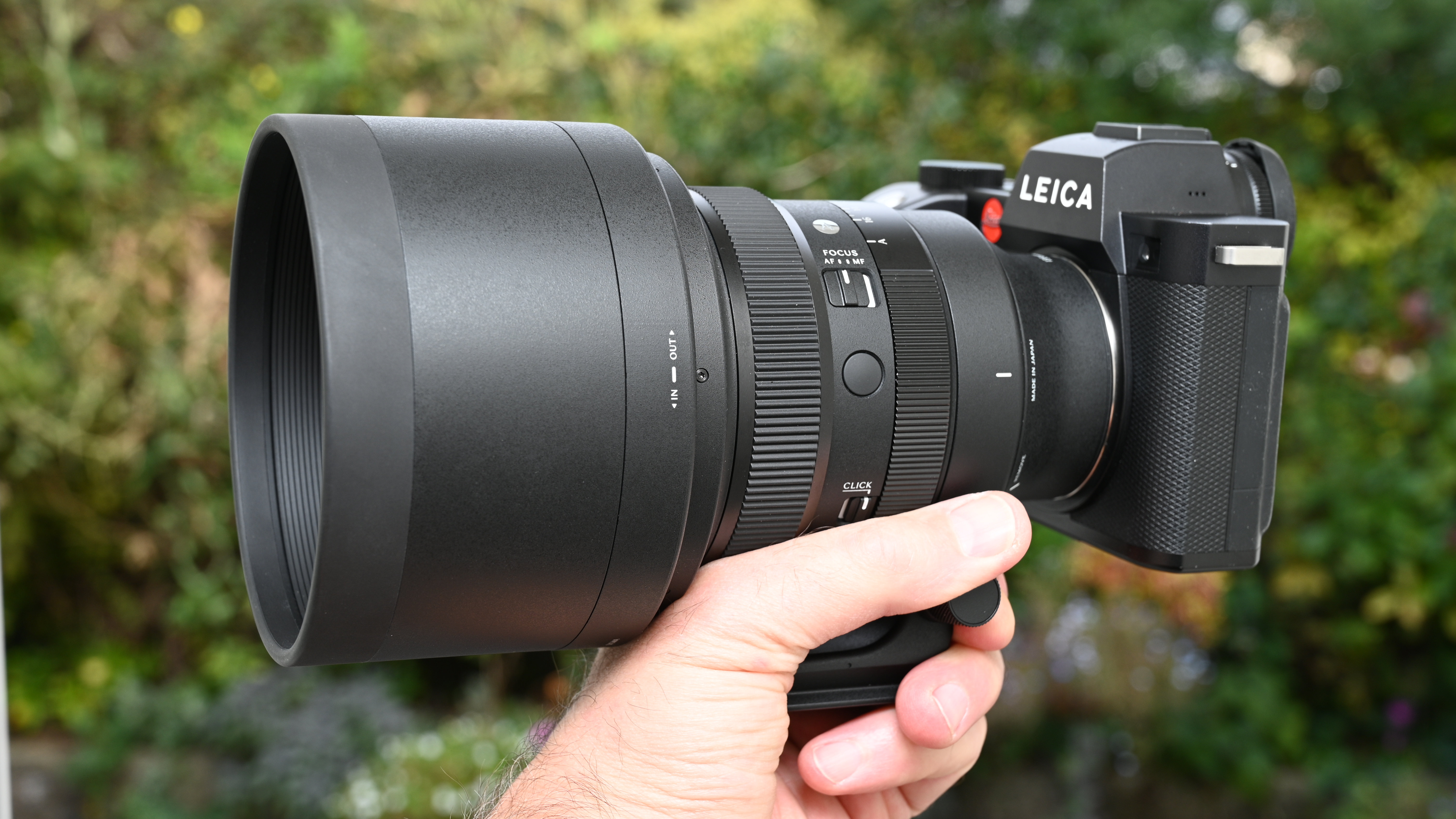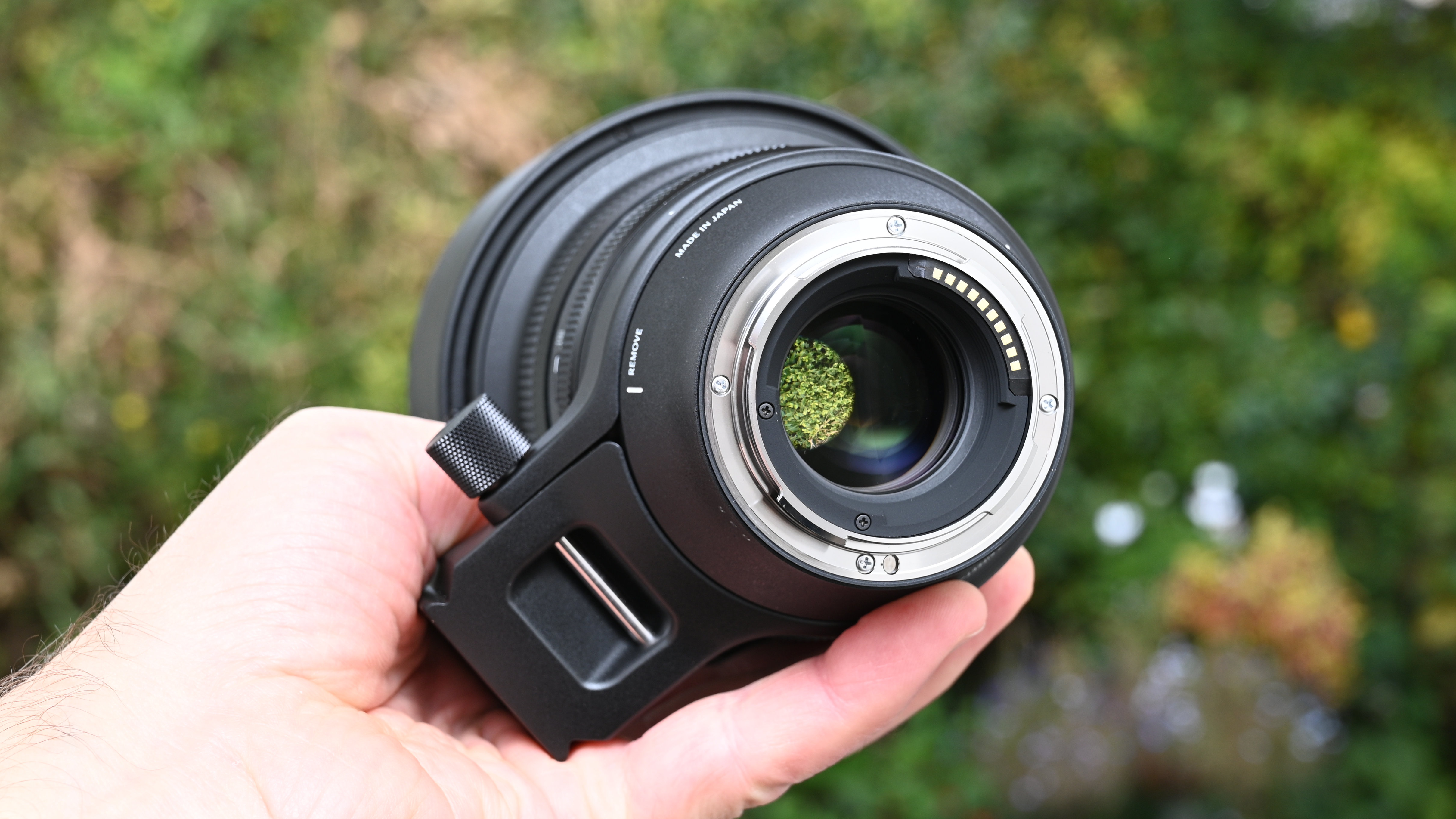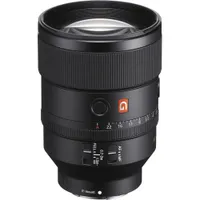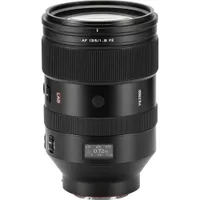Digital Camera World Verdict
The Sigma 135mm f/1.4 DG Art takes a popular focal length and shifts it up a gear. I’ve used various 135mm f/1.8 primes before and have generally been very impressed. This Sigma is two-thirds of an f/stop faster, enabling a tighter depth of field and the potential for even dreamier bokeh. That potential is realized to the full, thanks to the top-notch design and high-precision manufacture of the lens, making it the ultimate choice for beautiful blur along with scintillating sharpness.
Pros
- +
Go-faster f/1.4 aperture
- +
Fabulous image quality
- +
Sophisticated handling
- +
Super-fast autofocus
Cons
- -
Necessarily weighty
- -
Expensive (but great value)
- -
Only for E and L mount cameras
Why you can trust Digital Camera World
For tight head shots and head-and-shoulders portraiture, there are lenses that are all too ready to stand up and be counted. Best of breed 135mm primes include the Canon RF 135mm f/1.8L IS USM, Nikon Z 135mm f/1.8 S, and Sony FE 135mm f/1.8 G Master. I gave 5-star ratings and Gold awards to the latter two of these, and only knocked half a star off the rating for the sophisticated yet comparatively cut-price Viltrox AF 135mm f/1.8 LAB. All of these lenses are absolutely fabulous, but they all have two things in common – a focal length of 135mm and an aperture rating of f/1.8. There’s nothing wrong with that, but could things be even better?
Sigma has a long history of pushing the boat out and creating some really off-the-wall lenses, and the company shows no signs of slowing down. Recent world-firsts include the Sigma 300-600mm f/4 DG OS Sports and the Sigma 200mm f/2 DG OS Sports (at least for mirrorless cameras), to name but a couple.
The offering that I’m reviewing here takes the typical 135mm focal length but gives it a speed boost of two-thirds of an f/stop. The tighter depth of field gives the potential of even better bokeh, if the optical design and engineering are up to the task, along with faster shutter speeds for freezing motion under dull lighting conditions, without bumping up your camera’s sensitivity setting. Naturally, you can use this lens for action, sports, wildlife, landscape and still life photography, as well as a variety of other genres and even for astrophotography. However, portraiture is its best fit and the lens goes all out to be one of the best portrait lenses and one of the best L-mount lenses on the market.
Sigma 135mm f/1.4 DG Art: Specifications
Mount options | Sony E (FE), L-mount |
Lens construction | 17 elements in 13 groups |
Angle of view | 18.2 degrees |
Diaphragm blades | 13 |
Minimum aperture | f/16 |
Minimum focus distance | 1.1m |
Maximum magnification | 0.14x |
Filter size | 105mm |
Dimensions | 112x136mm / 4.4x5.4" |
Weight | 1,430g / 3.15lb |
Sigma 135mm f/1.4 DG Art: Price
What price bokeh perfection? Slower 135mm f/1.8 lenses can cost a pretty penny and for a ready reckoning, the Canon RF 135mm f/1.8L IS USM lists at $2,399 / £2,399 / AU$3,969, the Nikon Z 135mm f/1.8 S costs $2,597 / £2,649 / AU$4,299, and the Sony FE 135mm f/1.8 G Master sells for $2,248 / £1,599 / AU$2,799. A bit of a curved ball and typical of its breed, the Viltrox AF 135mm f/1.8 LAB is extremely competitively priced at just $899 / £829 / AU$1,539. The Viltrox aside, the Sigma beats the Canon, Nikon and Sony f/1.8 lenses on price most of the way around the world, despite being two-thirds of an f/stop faster and choc-full of fancy features. Ultimately, it looks potentially very good value at $1,899 / £1,649 / AU$3,999.
Sigma 135mm f/1.4 DG Art: Design & Handling
Something of a speed demon, this Sigma lens sets out to prove that faster is better. It’s not just a matter of featuring a faster aperture rating that transmits more light to the camera, gives an even tighter depth of field and enables quicker shutter speeds under dull lighting. It’s more about designing and engineering a lens that does all of these things in a way that actually improves image quality and all-round performance. That’s easier said than done.
If you want a telephoto lens that can pull in enough light to enable an f/1.4 aperture rating, you’re going to need big glass. Wide diameters are the order of the day and the design of this lens draws on no less than four large, top-grade FLD (‘Fluorite’ Low Dispersion) elements to boost sharpness and clarity while minimizing both axial and lateral chromatic aberrations. Indeed, the whole design is centered on blending standout sharpness with the most beautiful bokeh.
Naturally, there’s more to getting the ultimate in image quality than just great optical performance. The potentially razor-thin depth of field delivered by the combination a 135mm focal length and f/1.4 aperture puts huge demands on focusing accuracy. And you really don’t want autofocus to take ages taking aim, or you stand to miss fleeting expressions and other critical shots where timing is of the essence. Going for speed, accuracy and consistency, the Sigma features a dual HLA (High-response Linear Actuator) autofocus system, which move two groups of elements. Another upside of two separate groups being moved independently is that Sigma claims it enables consistently high resolution across the entire focus range.
The best camera deals, reviews, product advice, and unmissable photography news, direct to your inbox!
If you want to try your hand at manual focusing, there’s a control ring that’s electronically coupled to the focusing motors, and enables very fine and precise adjustments. You also get an AF/MF focus mode switch, to save the time and trouble of resorting to camera menus. Of more use (at least to my mind) is a pair of AF-Lock buttons that fall naturally under the thumb in both landscape and portrait orientation shooting modes. You can generally assign the buttons to alternative functions, depending on the camera body’s customization options.
It seems that a high-end lens isn’t complete these days unless it has an aperture control ring. The Sigma obliges with a dedicated ring that’s numbered in full f/stops and has line markers for intermediate one-third f/stop increments.
As I’d also expect for the mirrorless age, the aperture ring is tailored to suit both stills and video shooting, thanks to a click-de-click switch on the lens barrel. This makes precise and easily repeatable click steps available when shooting stills, as well as smooth and silent aperture transitions when shooting video.
One of my bugbears with aperture rings on many modern lenses is that it’s all too easy to nudge them from their ‘A’ (Auto) position accidentally. The upshot is that if you’re controlling the aperture from your camera body, for example in Program or Shutter priority shooting mode, or just for the sake of it, it’s all too easy to nudge the aperture ring and find yourself shooting at really narrow apertures by mistake. The Sigma solves the problem by featuring an aperture lock switch that locks the ring at its ‘A’ position.
Weighing in at 1,430g / 3.15lb, the lens is sufficiently lightweight for prolonged periods of handheld shooting, but too heavy for tripod mounting via the camera body’s threaded socket. As such, it comes complete with a tripod mounting ring which enables a much better balance, especially in portrait orientation mode, as well as making it relatively quick and easy to swap between landscape and portrait orientations.
As is usually the case nowadays, the foot of the tripod collar has an Arca-Swiss profile. I like that you can therefore attach it to a like-minded tripod head without needing to use an additional quick-release plate. And there’s still a regular mounting socket in case your tripod head doesn’t have Arca-Swiss compatibility.
The lens comes with a large, circular profile hood. Like the lens itself, it’s a quality item that has a ridged matte black inner surface to cut down unwanted reflections, and a lock/release button for security. Joining the battle against ghosting and flare, the lens features Sigma’s trusty Super Multi-Layer coatings. The front element also has a fluorine coating to repel moisture and grease.
Sigma 135mm f/1.4 DG Art: Performance
Autofocus lived up to its billing in my tests, being very agile and delivering excellent accuracy and consistency in equal measure. I’m very grateful for that, as the super-tight depth of field of which this lens is capable makes manual focusing tricky, to say the least. Fast lenses, especially of the telephoto variety, often suffer from axial/longitudinal chromatic aberration (LoCA), also known as bokeh fringing. This gives rise to color fringing at wide apertures around high-contrast transitions just in front of or behind the plane of focus, anywhere and everywhere across the image frame. The Sigma is designed to make this aberration as negligible as possible and I’d say the hard work has paid off, based on the results of my tests.
The following gallery of images comprises shots of a phrenology head taken against a backdrop of garden plants and flowers. I took the sequence at all full f/stop increments from wide-open at f/1.4 down to an aperture of f/11. It’ll give you and idea of the qualities of sharpness and bokeh, as well as the resistance to color fringing.





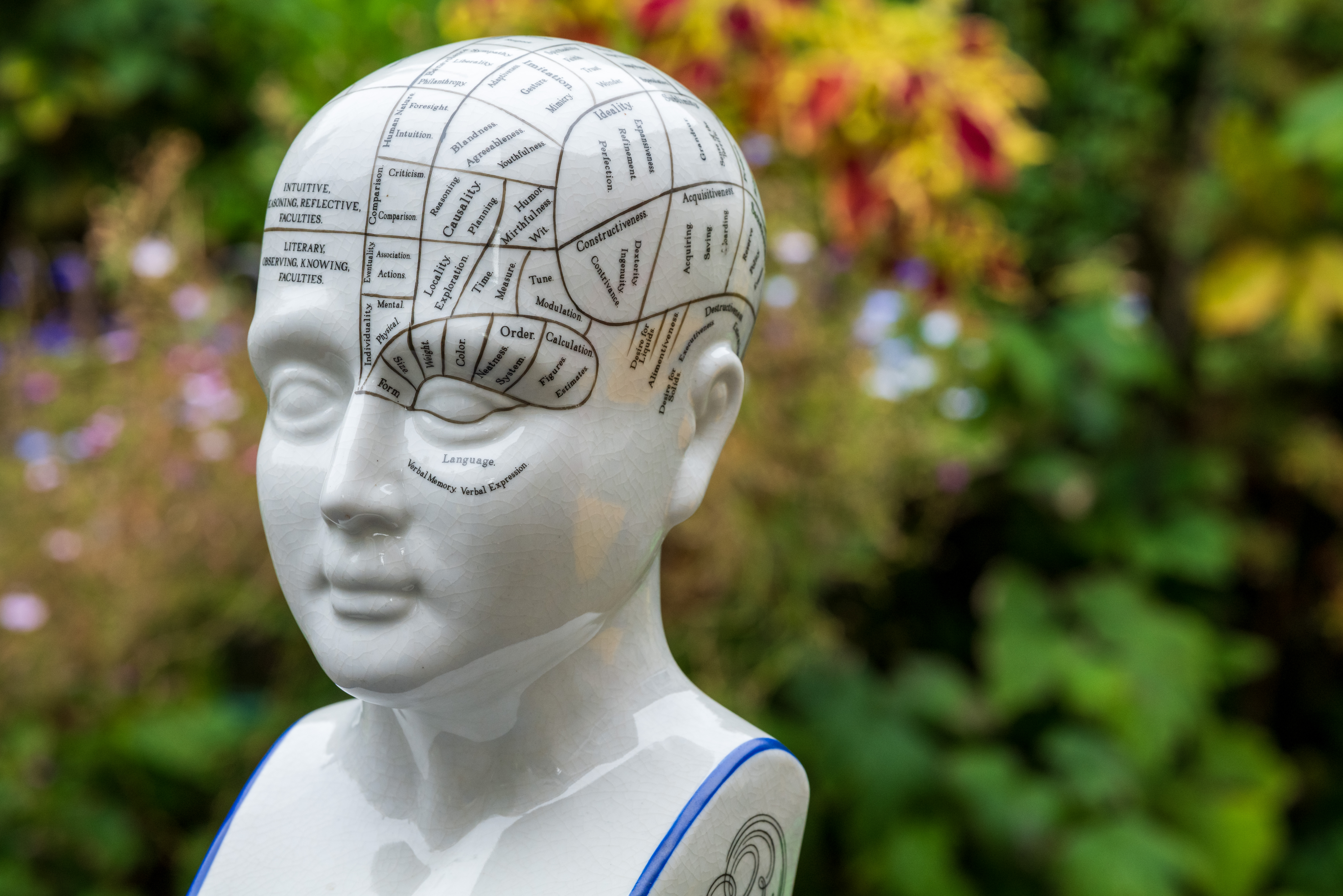

Sharpness, clarity, contrast and color rendition are all superb, even when shooting wide-open at f/1.4. That’s all well and good but the headline attraction is the quality of bokeh. Sure enough, bokeh looks wonderfully smooth and dreamy, and there’s a really natural looking roll-off between focused and defocused areas. It’s a testament to Sigma’s prowess and the knowledge that the company has gained through its history of making fast primes that the quality of bokeh is so gorgeous.
Bokeh disks produced by defocused lights and bright spots look smooth and soft-edged, and remain that way with circular profiles when stopping down, thanks to a particularly well-rounded 13-blade aperture diaphragm.
Naturally, you don’t always want to shoot at really wide apertures. You might prefer to stop down and increase your depth of field to ensure sharpness throughout a greater area of three-dimensional subjects. The picture of a restored railway wagon below demonstrates excellent sharpness right out to the edges and corners of the frame.
Sigma 135mm f/1.4 DG Art: Sample Images
The following gallery of example images was taken in and around Bristol Docks, in the south west of England. An upside of the dull lighting on an overcast day was that no neutral density filter was required for shooting at the widest aperture of f/1.4. The gallery also demonstrates the excellent performance of the lens in terms of sharpness, contrast, clarity, color rendition and bokeh, making the best of challenging lighting conditions.



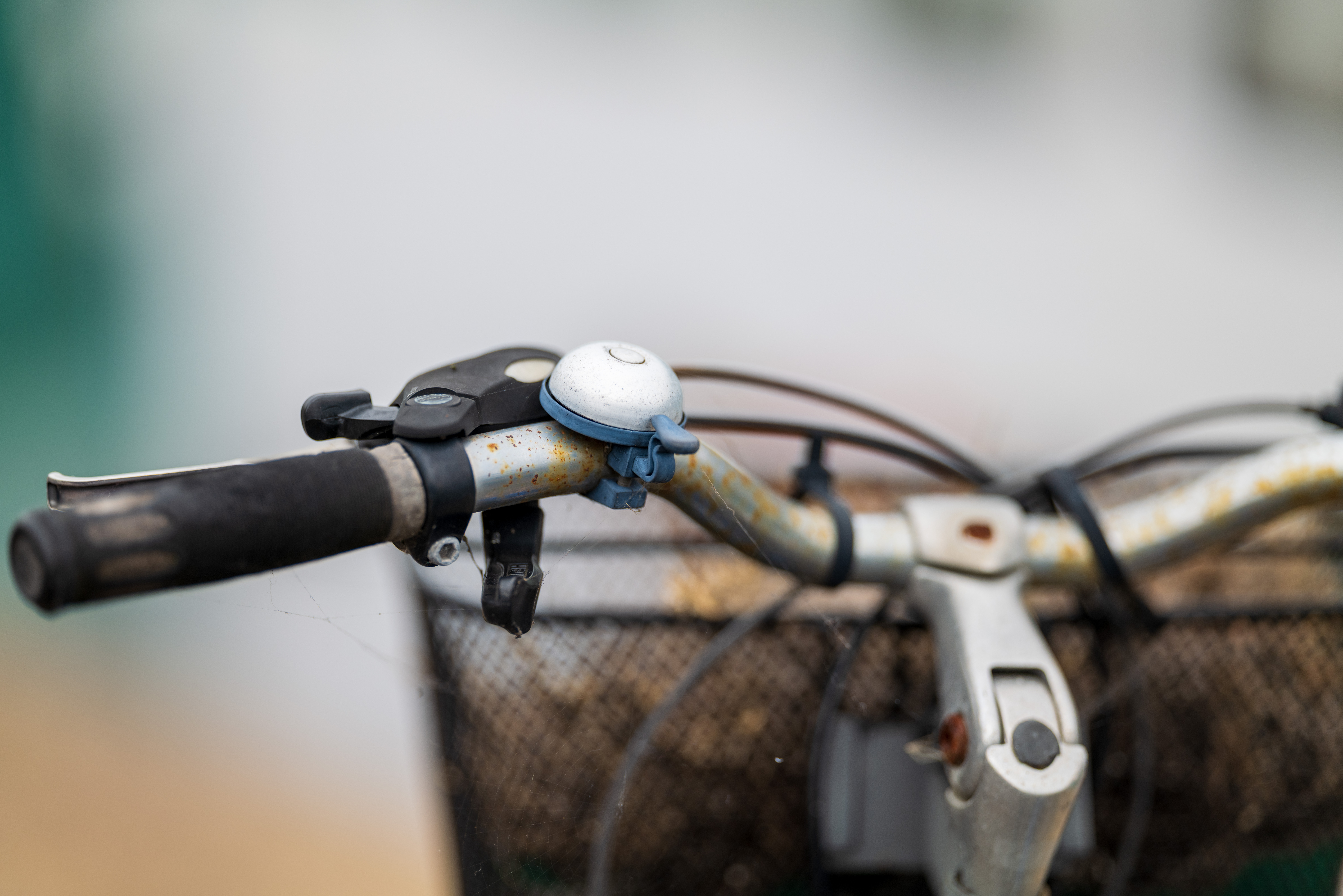










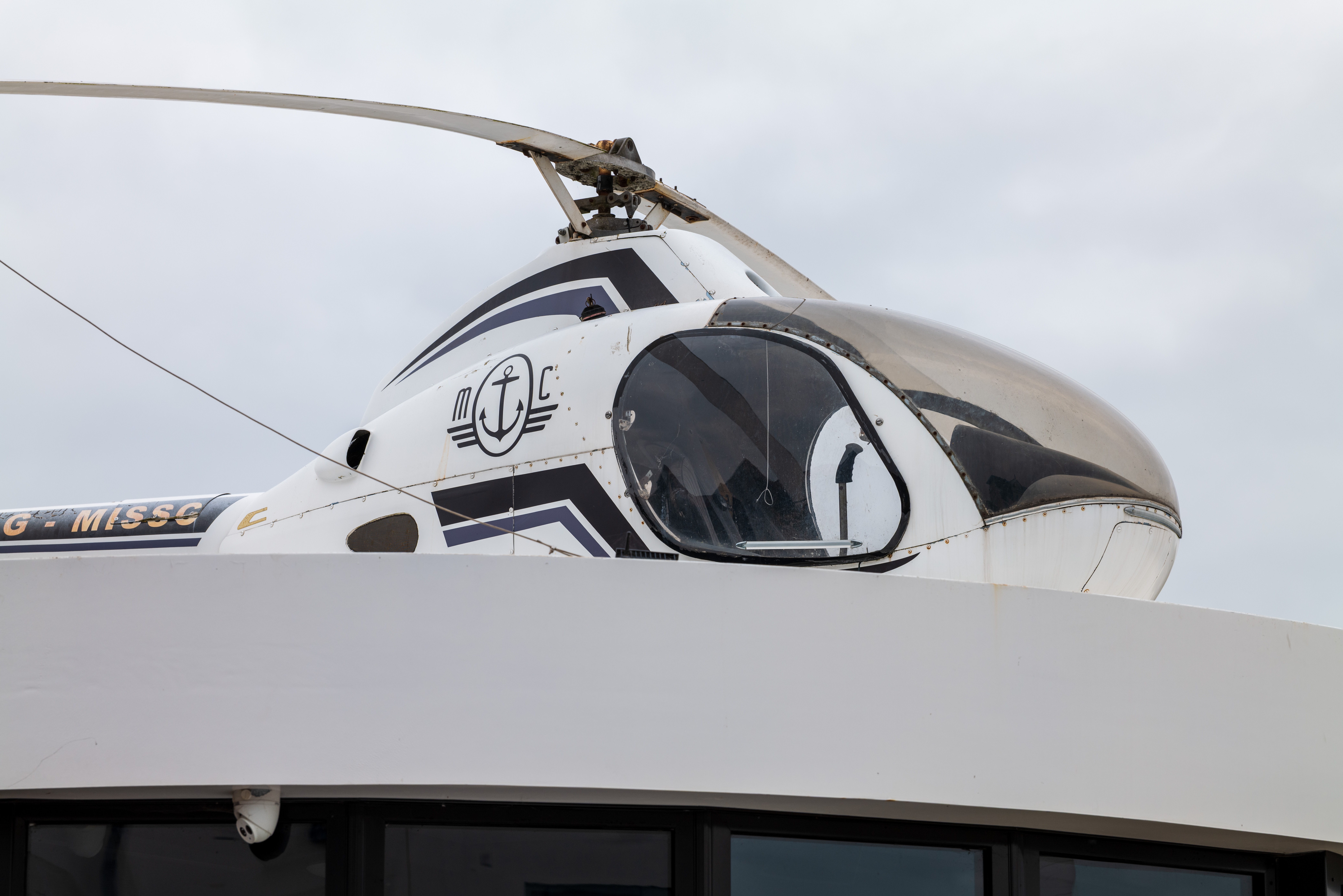


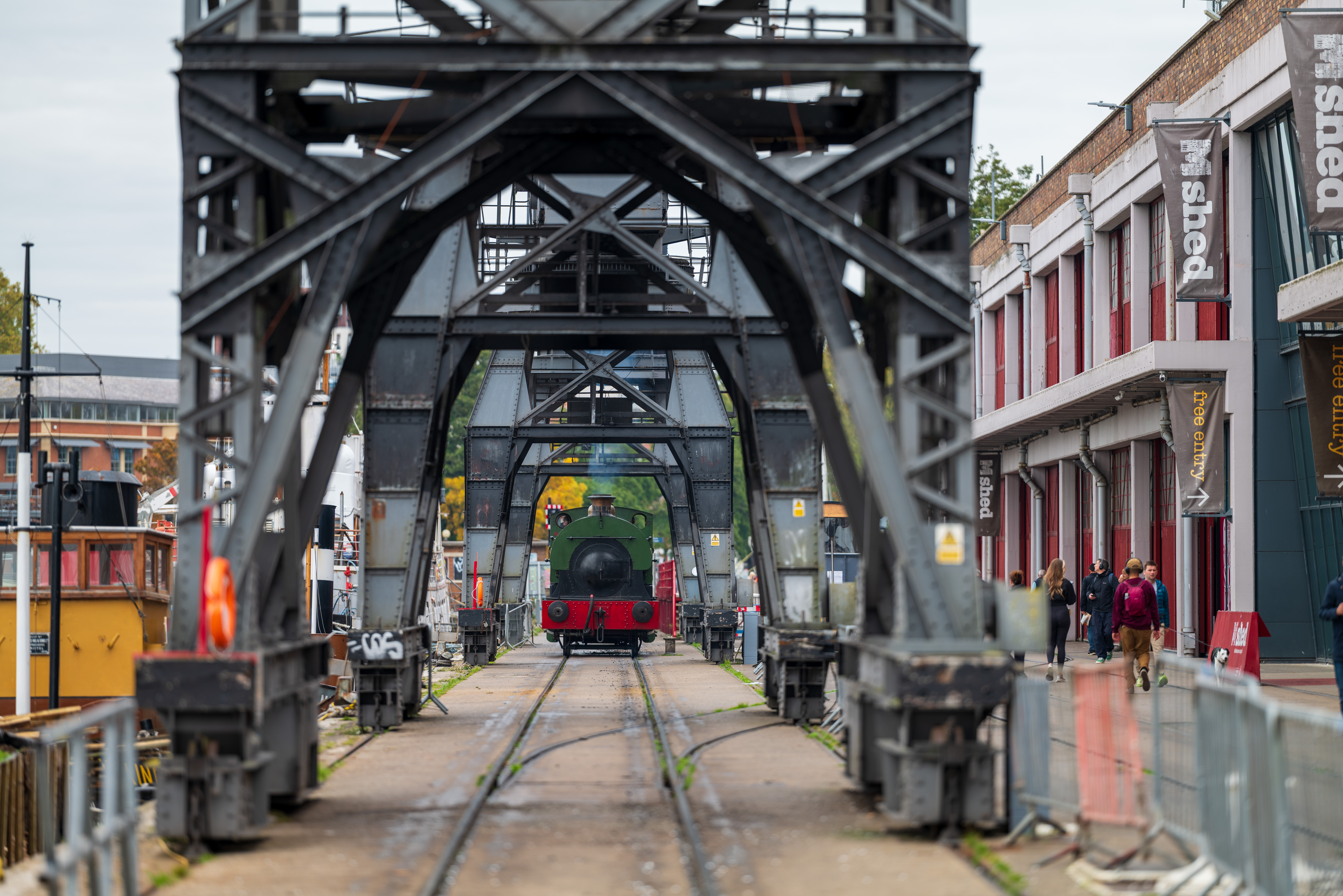



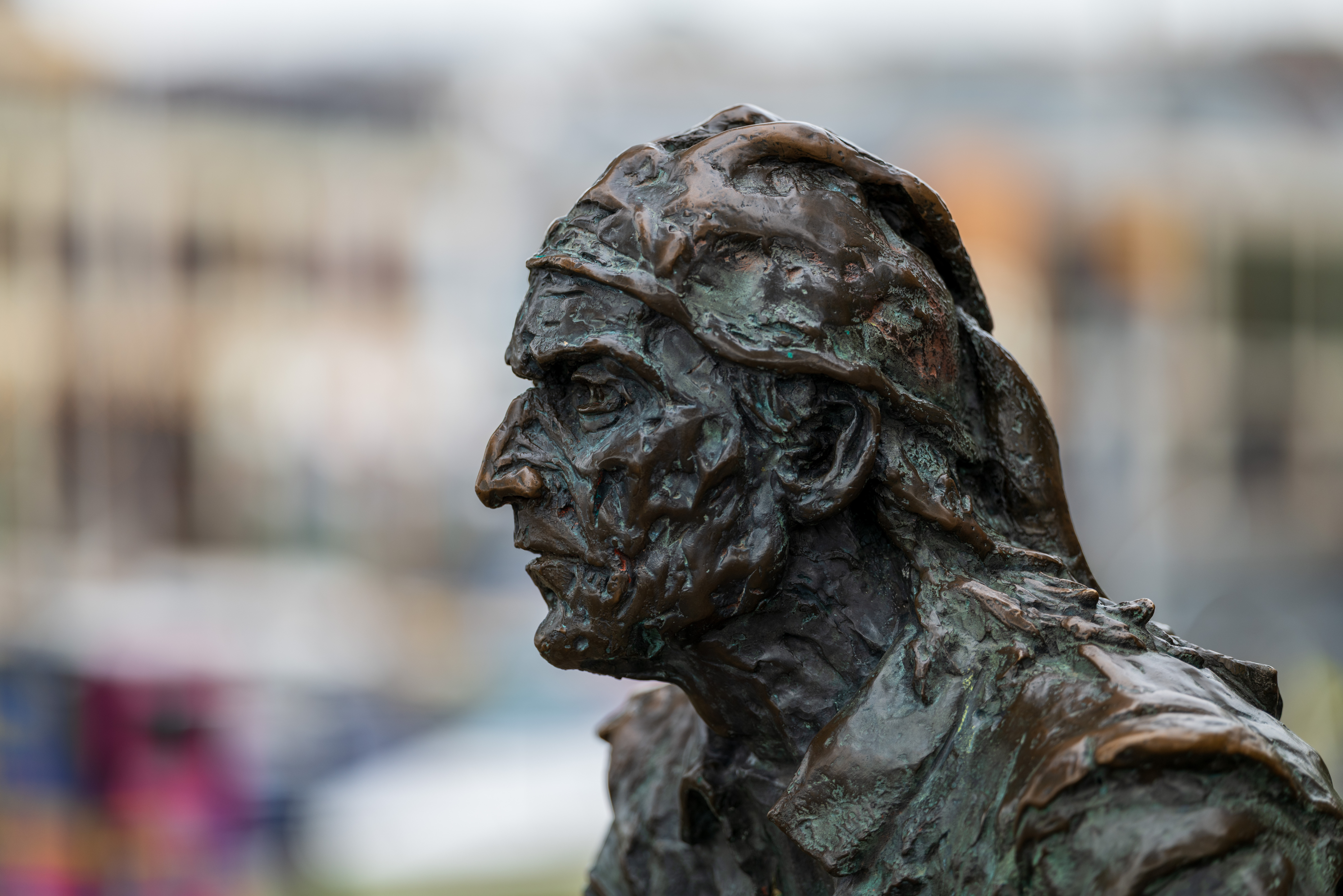
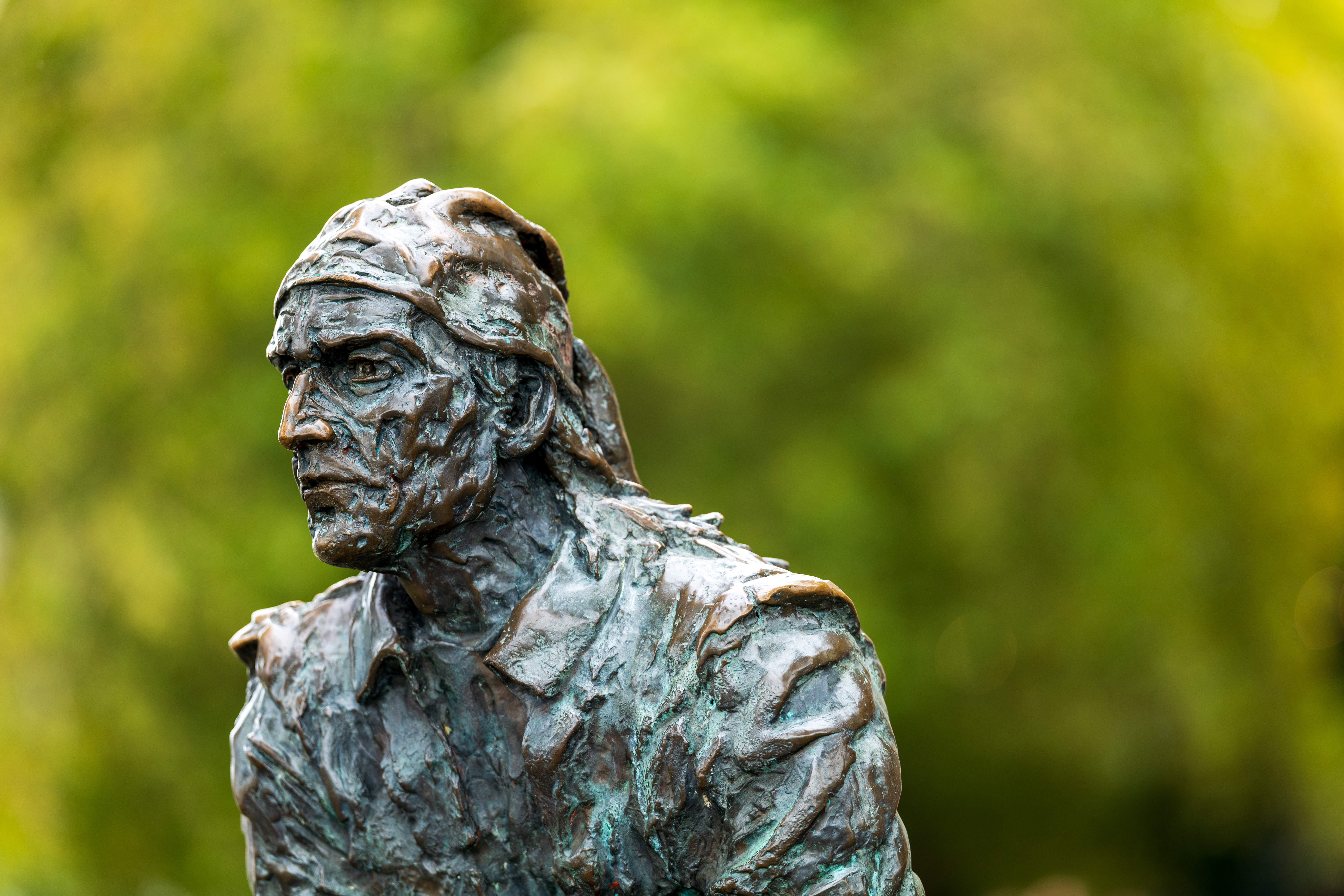

Sigma 135mm f/1.4 DG Art: Lab Results
We run a range of lab tests under controlled conditions, using the Imatest Master testing suite. Photos of test charts are taken across the range of apertures and zooms (where available), then analyzed for sharpness, distortion and chromatic aberrations.
We use Imatest SFR (spatial frequency response) charts and analysis software to plot lens resolution at the center of the image frame, corners and mid-point distances, across the range of aperture settings and, with zoom lenses, at four different focal lengths. The tests also measure distortion and color fringing (chromatic aberration).
Sharpness:
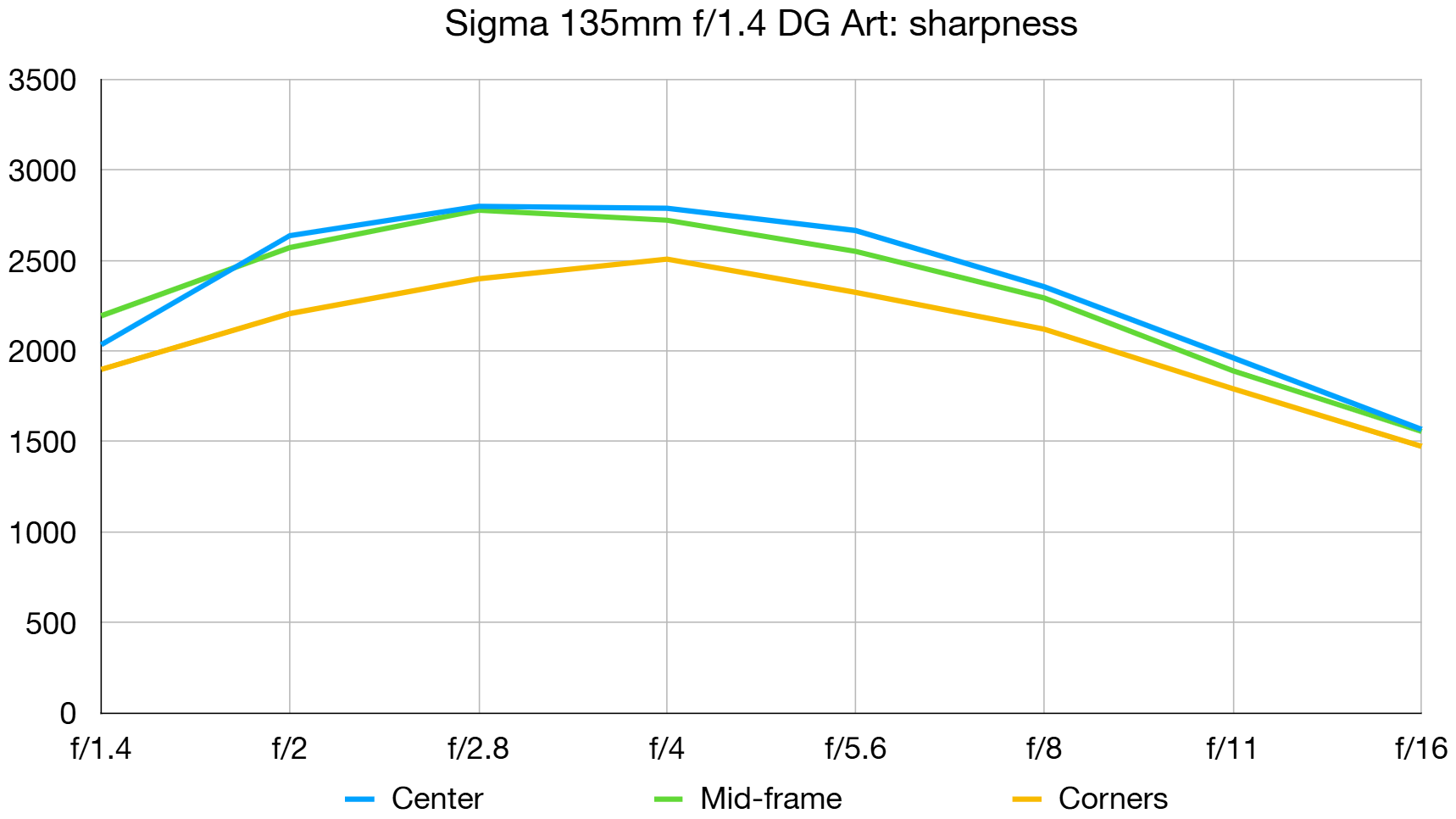
Even wide-open at f/1.4, the Sigma is sharper at the extreme edges and corners of the image frame than many prime lenses are at the center. All in all, sharpness is both superb and impressively uniform across the whole image frame, especially when stopping down to apertures between f/2 and f/8.
Fringing:
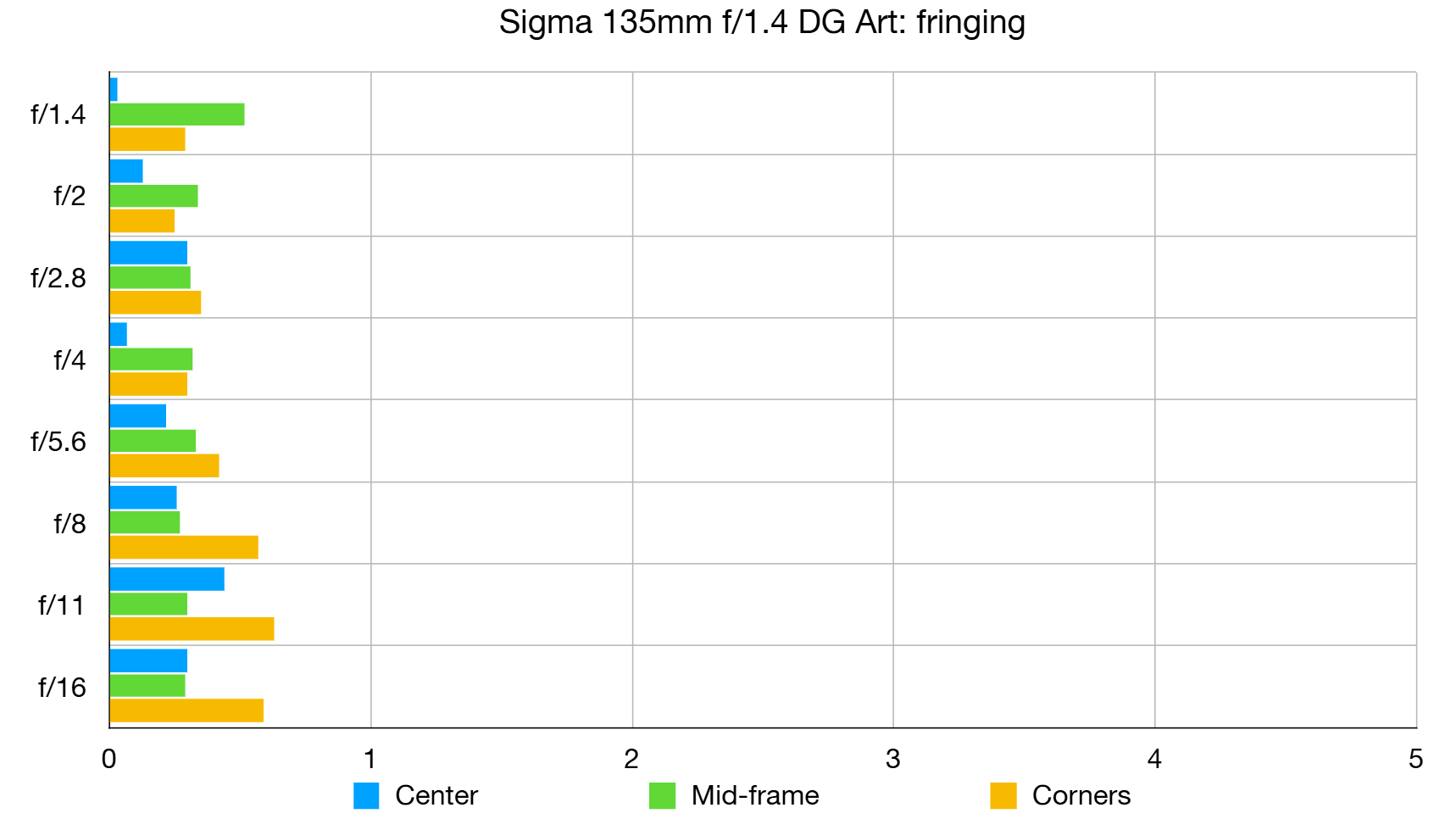
Both lateral and axial/longitudinal chromatic aberrations are entirely minimal. Even uncorrected, lateral chromatic aberration is negligible out at the extreme edges and corners of the frame, while LoCA is of a similarly low order across the whole frame at the widest aperture of f/1.4.
Distortion: -0.11
This Sigma is virtually a zero-distortion lens. With no in-camera correction applied, you’ll be hard-pressed to see the extremely small amount of barrel distortion during real-world shooting, that’s only really revealed as a small mathematical number in lab tests.
Sigma 135mm f/1.4 DG Art: Verdict
It’s a kind of magic. I’ve been entranced by the pictorial quality of some 135mm f/1.8 lenses in the past, from a variety of manufacturers. This f/1.4 prime takes everything to a higher plane. Scintillating sharpness and clarity combines with lavishly soft bokeh to give a truly artistic look to images. And the Sigma’s outstanding image quality is reinforced in practical terms by rapid and unerringly accurate autofocus, delivering an excellent hit rate even in challenging conditions. In my opinion, it’s simply one of the best lenses of all time, and an absolute dream for portraiture and still life photography.
Features ★★★★★ | Useful features include dual customizable function buttons, a click/de-click aperture ring with locking switch, and an Arca-Swiss compatible tripod mounting collar. |
Design ★★★★★ | The design combines a top-level optical path with premium build quality and excellent handling characteristics. |
Performance ★★★★★ | Fast and consistently accurate autofocus makes the most of superb sharpness, but bokeh is the standout facet of performance. |
Value ★★★★★ | All things considered, the Sigma is excellent value for money at the price. |
Alternatives
The Sony FE 135mm f/1.8 G Master has similar attractions including an aperture control ring and dual function buttons, while also adding an autofocus range limiter. However, it’s two-thirds of an f/stop slower than the Sigma.
The Viltrox AF 135mm f/1.8 LAB is relatively inexpensive to buy but is surprisingly feature-rich, with a click/de-click aperture ring, function buttons and even a color LCD info display. It’s available in Sony E and Nikon Z mount options.
Matthew Richards is a photographer and journalist who has spent years using and reviewing all manner of photo gear. He is Digital Camera World's principal lens reviewer – and has tested more primes and zooms than most people have had hot dinners!
His expertise with equipment doesn’t end there, though. He is also an encyclopedia when it comes to all manner of cameras, camera holsters and bags, flashguns, tripods and heads, printers, papers and inks, and just about anything imaging-related.
In an earlier life he was a broadcast engineer at the BBC, as well as a former editor of PC Guide.
You must confirm your public display name before commenting
Please logout and then login again, you will then be prompted to enter your display name.


